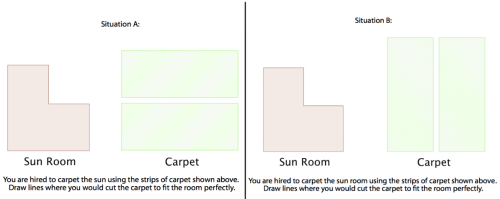#MakeoverMonday – Sun Room Carpet
This is my attempt to revise the textbook problem Dan Meyer posted here:
Bedroom Carpet is next week's #MakeoverMonday task. What can you do with this? http://t.co/pTyPK3DbsA
— Dan Meyer (@ddmeyer) June 27, 2013
What I did:
- Bring the most interesting part of the problem (to me) to the front of the task. The idea of requiring the seams to go in the same direction with a minimum number of seams is the only opening for multiple answers in this problem. Start with this, and the students will already have a chance to disagree about answers, which we know is a good way to get conversations going.
- Frame this possibility of multiple arrangements visually, not with text. By placing the carpet strips in different configurations when first displaying the task, I’m nudging students toward different answers. Again, this conflict is important to spicing up a pretty plain textbook task.
- Get rid of those mixed metric/English units immediately. There is no reason that a person would measure the room in meters and then deal with a store that sells in feet and yards. There’s enough here to keep things interesting without dealing with meters and yards.
- Leave out unnecessary vocabulary like ‘bolt’ and ‘seam’. One more move to reduce the text overload of the problem.
Here’s the rundown of the lesson:
Hand out slips of paper with either Situation A or Situation B shown below.
Once students have drawn their lines, share a few of the drawings to show the differences. Pose the question: Which situation (A or B) will require more cutting?
Have students make and record their guesses.
Move to the second act here. What information would you need to answer the question precisely?
There’s some wiggle room here for what happens next. If the students ask for the measurements, you could give them this diagram:

In reality though, students could figure this out just by making measurements with a ruler on the diagram. No big deal either way.
We then ratchet up the task by bringing up the tape factor:

The students might not realize that the carpet is attached at the edges of the room (though not usually with tape) which is why it’s important to bring up this point. At this point the dimensions diagram still might be requested, but it isn’t really necessary until students start reporting their answers. What units are involved?
It would be at this stage when I would actually ask the students which situation is the better option for carpeting the room. The ambiguity is on purpose – students need to decide what it really means for a situation to be better. Is it cost? Time required to cut? Amount of tape? All of these factors come into play. The original problem ultimately asks what the total cost is for the carpet and the tape, but there are lots of possibilities for what can be done at this point in the lesson. Here are some possibilities:
At the hardware store, you learn the following:
- A 30 foot roll of double sided tape costs $4.85
- The carpet sells for $22.95 per square yard
What is the minimum cost to carpet the room?
Or, building on that information:
Suppose you also make $11.50 per hour to lay carpet.
Which situation do you choose to maximize the money you make on the job? What information would you need to answer this question?
Having students work to answer this efficiently means getting students that have worked on the two situations to talk to each other.
Follow up questions to throw in:
- If you had a choice of 3, 5, or 12 foot wide strips of carpet, which would result in the cheapest overall job
- If you can cut the carpet at 2.5 inches/second for a straight cut, with an additional second for each cut, how long would it take for you to prep the carpet for the room?
This is my first attempt in the Make over Monday series, and I’m exhausted. Also, this was fun. What’s next, Dan?



For me, there’s nothing to critique here. You’ve clarified what’s important and turned a routine problem into something that makes students curious. It’s obvious you have spent a lot of time on this. Teachers and students are the beneficiaries. Thanks!
Actually, since the problem comes from Canada-
“This task comes from MathWorks, which, as I understand it, is intended for Canada’s vocational track math students.” -Dan Meyer’s post
-students have to learn how to think in feet with metric measurements. Our largest trade partner has decided to stick with Imperial, so this woman could very well have measured her room looking at meters and gone to the store realizing that the carpet she wants is sold by the foot.
C’est la vie!
For example: we buy gas by the litre, but still refer to MPG; older generations still refer to weather in Fahrenheit, so us young people have to remind ourselves that our blood won’t boil when we hear it will be 100 degrees the next day.
Hi Lucia,
I stand corrected, now that I have seen Dan’s post. I still maintain that it is distracting, but I retract my statement that it is an artificially inserted complication.
On a related note, if you haven’t seen the White House response to a petition on changing to metric, it is a hoot:
https://petitions.whitehouse.gov/response/supporting-american-choices-measurement